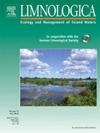Feeding ecology of two sympatric Cyprinidae, Sarmarutilus rubilio (Bonaparte, 1837) and Scardinius erythrophthalmus (Linnaeus, 1758) in Sidi Salem reservoir (Tunisia)
IF 2
4区 环境科学与生态学
Q2 LIMNOLOGY
引用次数: 0
Abstract
The provided information outlines a study conducted on the diet and feeding relationships of two species, Sarmarutilus rubilio (near threatened) and Scardinius erythrophthalmus, in the largest water reserve in Tunisia, Sidi Salem. Both species are introduced and are the most abundant in the reservoir. They share the same food resources, with macrophytes being the primary component of their diet, especially for S. erythrophthalmus, Macrophytes accounting for 77.78% of its diet. The second most important prey category for both species is Arthropoda. Additionally, there are other prey categories such as Cyanobacteria, Microalgae, Nematoda, and Sand, but these are ingested by both species in lower proportions (%PV < 1.5). S. rubilio, outside its native area, maintains its feeding plasticity The study revealed some differences in the diet of the two species. For S. erythrophthalmus, variations in diet were observed among seasons, while for S. rubilio, variations were observed among different stations within the reservoir. Both species were found to have narrow niche breaths, indicating specialized feeding habits. Despite these variations, the diets of the two species showed significant overlap. The research highlights the feeding ecology of S. rubilio and S. erythrophthalmus outside their native range. This information can be valuable for developing future fishery management plans and biodiversity preservation strategies in Tunisian freshwater systems. Understanding the feeding preferences and interactions between these introduced species can aid in maintaining a balanced ecosystem and conserving the native species in the region. Considering that S. rubilio is categorized as near threatened, such knowledge becomes even more crucial for effective conservation efforts.突尼斯西迪塞勒姆水库两种同属鲤科:rubilio和Sarmarutilus rubilio (Bonaparte, 1837)和cardinius erythrophthalmus (Linnaeus, 1758)的取食生态学
所提供的资料概述了在突尼斯最大的水域西迪塞勒姆对两种物种,即rubilio Sarmarutilus(近受威胁)和Scardinius erythrophthalmus的饮食和摄食关系进行的研究。这两种都是引进的,是水库中最丰富的。它们共享相同的食物资源,以大型植物为主要的饮食成分,尤其是红眼棘球绦虫,大型植物占其饮食的77.78%。对这两个物种来说,第二重要的猎物类别是节肢动物。此外,还有其他的猎物类别,如蓝藻、微藻、线虫和沙子,但这两种物种摄取的比例较低(%PV < 1.5)。该研究揭示了两个物种在饮食上的一些差异。红眼S. red - phthalmus的食性随季节变化,而红眼S. rubilio的食性随水库内不同站点的变化而变化。这两个物种都有狭窄的生态位呼吸,表明它们有特殊的进食习惯。尽管存在这些差异,但这两个物种的饮食表现出明显的重叠。本研究重点研究了红眼S. rubilio和红眼S. red phthalmus在其原生地外的摄食生态。这些信息对于制定突尼斯淡水系统未来的渔业管理计划和生物多样性保护战略具有重要价值。了解这些引进物种之间的取食偏好和相互作用有助于维持该地区生态系统的平衡和保护本地物种。考虑到红宝石被归类为近危物种,这些知识对于有效的保护工作变得更加重要。
本文章由计算机程序翻译,如有差异,请以英文原文为准。
求助全文
约1分钟内获得全文
求助全文
来源期刊

Limnologica
环境科学-湖沼学
CiteScore
3.70
自引率
5.90%
发文量
64
审稿时长
3 months
期刊介绍:
Limnologica is a primary journal for limnologists, aquatic ecologists, freshwater biologists, restoration ecologists and ecotoxicologists working with freshwater habitats.
 求助内容:
求助内容: 应助结果提醒方式:
应助结果提醒方式:


